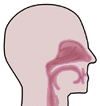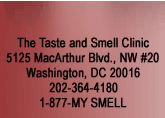  |
||
 |
In order to understand, evaluate and treat patients with taste disorders, it is necessary to measure taste ability or acuity. This is similar to being able to understand blindness or deafness among people who have visual or hearing loss. For visual loss, physicians have used simple tests — the Snellen Eye Test — and more complicated tests- to measure visual acuity. For hearing loss, physicians have used various tests to measure hearing acuity — many of us have been tested using earphones listening to a weak tone and raising our finger when we heard it. Just as with these attempts to measure visual and auditory acuity to determine these sensory losses it is important to measure taste acuity to determine loss of taste function. But how is this done and can it be done with the same accuracy as measurements of vision and hearing? At the Taste and Smell Clinic of Washington, DC, we have pioneered techniques to measure taste acuity with the same or even better accuracy used to measure vision and hearing. How has this been accomplished? The Techniques There are multiple methods to measure taste function which involve several types of stimuli. For some time at The Clinic, we have determined that techniques similar to those used in measurements of hearing are the best and most accurate to adapt to measure taste function. They involve specific psychophysical techniques. The Context The psychophysical techniques use measurements involving the subject, the tester and the context in which these measurements are undertaken. The subject pays close attention to the test and this is verified by the tester. Specific instructions are given to the subject by the tester so that specific responses are forthcoming. The tester engages the subject so that he/she is focused on the specific task at hand. The context of the testing must be clearly defined so that all involved are attentive and comfortable with the test. The Measurements Testing involves a three stimuli forced choice drop technique given in a type of staircase technique. The subject is given three drops of liquid which are placed successively onto the lingual surface. Two of the drops are water and one drop is water plus a solute, either NaCl (salt), sucrose (sweet), HCl (sour) or urea (bitter). While only these four stimuli are used, there are several more stimuli that could be used e.g. metallic, or umami. Each of the solutions used is a physiological substance and is found in the body thus obviating any need for any foreign substance to be placed in the mouth. In a complex series of tests, DETECTION and RECOGNITION THRESHOLDS (DT, RT) are determined for each substance. At the same time that these thresholds are determined measurements of MAGNITUDE ESTIMATION (ME) (TASTE INTENSITY) are made. Simultaneously, measurements of HEDONIC QUALITY (HQ) or TASTE PREFERENCE are made. In this manner the TIME taken to test taste function is minimized while obtaining a maximum amount of information. This is critical to avoid tiring the subject so that focus is not lost. Many normal subjects were originally tested so that responses of patients could be verified against normal standards. In this manner quantitative measurements of several aspects of taste acuity are measured and compared to normal responses. A specific pattern of loss can be determined for each patient just as with loss of visual and auditory acuity. The Interpretation Patients may exhibit many types of abnormalities of DT, RT, ME or HQ. Each of these abnormalities plays a role in the diagnosis and subsequent treatment of the loss of taste acuity. For example, a decreased RT but normal DT may signify a brain dysfunction in taste pathways, but decreased DT and RT may signify a taste receptor dysfunction; decreased ME with normal DT and RT may signify that both taste brain pathways and taste receptor function are normal but there is a decrease in taste receptor number. Each of these abnormalities is important in establishing the cause of taste loss and then determining an appropriate course of treatment to correct the taste loss. Taste acuity is also modified by many physiological parameters. Time of day of testing (CIRCADIAN VARIATION) is important since taste acuity becomes more sensitive later in the day. For women, MENSTRUAL STATUS is important since taste acuity is more sensitive prior to ovulation. AGE is important since as people get older ME decreases. Many other physiological and pathological parameters influence taste acuity. Many of these parameters were discovered by work at the Taste and Smell Clinic of Washington, DC. Knowledge of these parameters is critical to establish an appropriate diagnosis reflected by the loss of taste acuity and then to initiate an appropriate treatment regimen to correct the loss. This type of interpretation has been established at the Taste and Smell Clinic and used to establish specific clinical diagnoses based upon the results of these tests and from there results to initiate specific treatment protocols to correct these losses. Taste Distortions Not only is it important to measure taste acuity, but the tests pioneered at Taste and Smell Clinic of Washington, DC have been used to measure taste distortions. RT measures recognition of salt, sweet, sour and bitter. However, patients with loss of taste acuity commonly develop taste distortions such that salt may taste metallic or sweet may taste rotten. These changes would reflect alterations in taste brain pathways which follow the loss of acuity. They fall under the general neurological disorder called "deafferentation hypersensitivity" and reflect changes in specific brain neurotransmitters. These changes are specified and measured by the unique testing techniques developed at the Taste and Smell Clinic of Washington, DC. These changes are important to measure so that specific diagnoses of patients can be made and effective treatment given to them. A shortened version of the complete battery of taste function tests used at The Clinic has also been devised. This short test is currently being used by clinicians around the world. It is a called AccusensT and is a quick but accurate method to study taste function. For further information about measurements of taste function used at the Taste and Smell Clinic of Washington, DC, please review the following publications in the scientific and medical literature:
Home
| The Clinic | Diagnosis
| Treatment | FAQ
| Press |
|